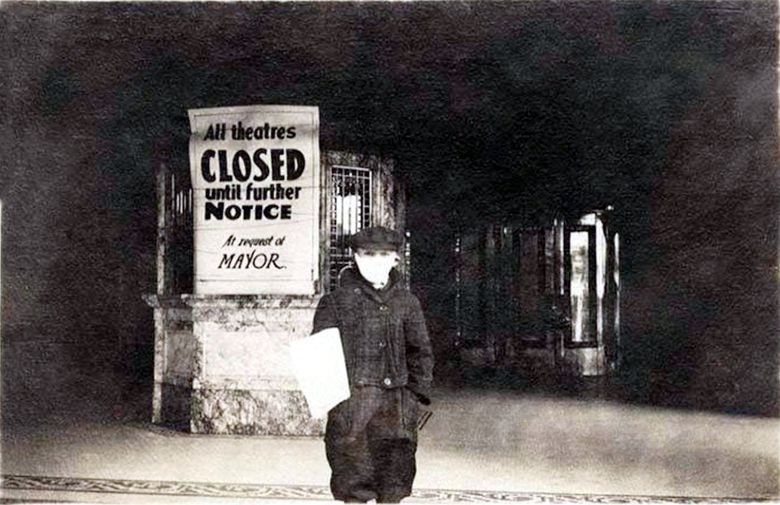There’s no covering up the message of this masked boy
July 9, 2020 at 7:00 am
Standing alone, staring at the camera (and seemingly at us), is a nameless preteen, labeled only as a newsboy. Behind him is the box office of the vaudevillian Pantages Theatre, on the east side of Third Avenue near University Street. The stark sign reflects an order on Saturday, Oct. 5, 1918, by Seattle Mayor Ole Hanson to close theaters, churches and schools and cancel public gatherings to slow the flu pandemic.
We don’t know who posed the masked boy or why, and we can’t find evidence that a Seattle newspaper published the photo. But the boy’s example bears a plea: What will we do today for the sake of tomorrow?
Curiously, public policy on masks that autumn was halting. Masks were absent from initially publicized anti-flu tips, which included using handkerchiefs for sneezes and avoiding crowds. Kissing, too, was disfavored. With a straight face, The Seattle Times reported, “This practice should be stopped except in cases where it is absolutely indispensable to happiness.”
But momentum was building for masks. Their first mention in The Times (other than gas masks for overseas combat) came Oct. 10, 1918, when the Red Cross was said to be making them by the thousands. An “urgent appeal” bid women to assist in their manufacture. On the lighter side, a fashion article Oct. 18 proclaimed flu masks, especially chiffon veils, “a necessity in milady’s wardrobe.”
Finally came official action. On Oct. 24, the city ordered barbers to mask up. By Oct. 26, the order covered restaurant workers and counter clerks and, by Oct. 27, messengers, bank tellers and elevator operators. On Oct. 28, masks became mandatory on streetcars.
Some officials grumbled. Thomas Murphine, utility superintendent: “I know now how a mule feels when its head is shoved into a nosebag.”
Newspapers beseeched cooperation. “It is easy to be cynical and skeptical,” the Seattle Star said in a front-page banner on Oct. 30, “but knocking and scoffing aren’t going to keep down the toll of deaths.”
One day after the Nov. 11 armistice, in tune with jubilation over the Great War’s end, Seattle’s mask orders and theater closures were rescinded.
In today’s pandemic, who knows when or why masking will cease, but the century-old plea remains: What will we do for the sake of tomorrow?


Good Find
They didn’t seem to help than and they won’t now.
There is always push back: https://en.wikipedia.org/wiki/Anti-Mask_League_of_San_Francisco
Hasn’t there been a push back on seat belts also? Smoking, junk food?
There must be a long list……….
Yes …My body my choice…it’s a libertarian thing
Don’t mess with my junk food Steins !
Typhoid Mary was a Libertan…
Libertarian…